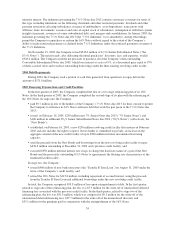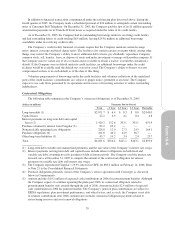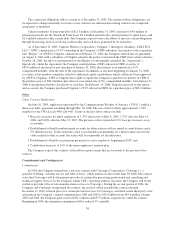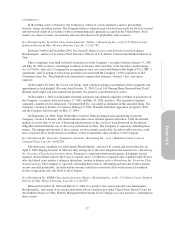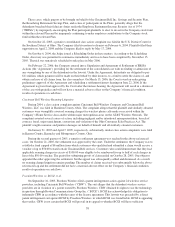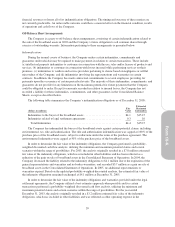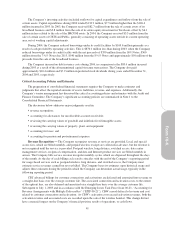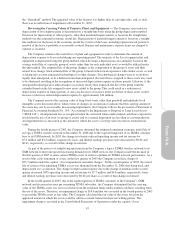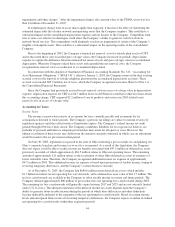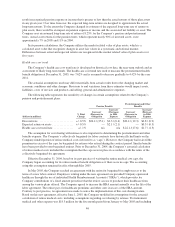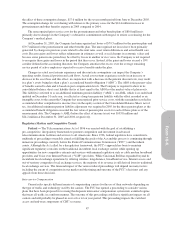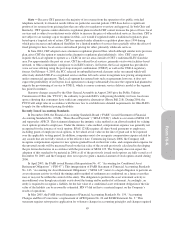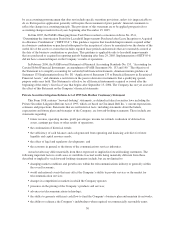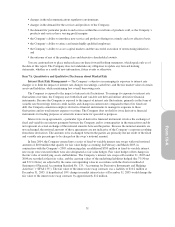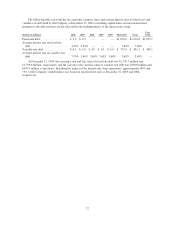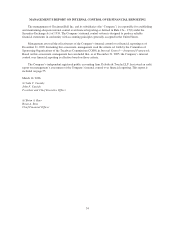Cincinnati Bell 2005 Annual Report Download - page 94
Download and view the complete annual report
Please find page 94 of the 2005 Cincinnati Bell annual report below. You can navigate through the pages in the report by either clicking on the pages listed below, or by using the keyword search tool below to find specific information within the annual report.impairments and other charges.” After the impairment charges, the carrying value of the TDMA assets was less
than $1 million at December 31, 2005.
If technological change were to occur more rapidly than expected, it may have the effect of shortening the
estimated depreciable life of other network and operating assets that the Company employs. This could have a
substantial impact on the consolidated depreciation expense and net income of the Company. Competition from
new or more cost effective technologies could affect the Company’s ability to generate cash flow from its
network-based services. This competition could ultimately result in an impairment of certain of the Company’s
tangible or intangible assets. This could have a substantial impact on the operating results of the consolidated
Company.
Prior to the beginning of 2003, the Company estimated net removal costs for outside plant assets of CBT
and to the extent these costs exceeded gross salvage values, the Company increased its periodic depreciation
expense to capture the difference between estimated net removal costs and gross salvage values in accumulated
depreciation. When the Company retired these assets and expended the net removal costs, the Company
recognized net removal costs as a reduction to accumulated depreciation.
In connection with the adoption of Statement of Financial Accounting Standards No. 143, “Accounting for
Asset Retirement Obligations” (“SFAS 143”), effective January 1, 2003, the Company removed the then existing
accrued costs for the removal of outside telephone plant from the accumulated depreciation accounts. These
accrued costs totaled $85.9 million, net of taxes, which the Company recognized as income. Refer to Note 1 to
the Consolidated Financial Statements.
Since the Company had previously accrued for net removal costs in excess of salvage value in depreciation
expense, depreciation expense for CBT was $6.7 million lower in 2003 than it would have otherwise been absent
this accounting change. CBT expensed $2.2 million of cost of products and services in 2003 related to net
removal costs in excess of salvage value.
Accounting for Taxes
Income Taxes
The income tax provision consists of an amount for taxes currently payable and an amount for tax
consequences deferred to future periods. The Company’s previous tax filings are subject to normal reviews by
regulatory agencies until the related statute of limitations expires. The Company’s federal income tax audit
periods through 2001 have been closed. The Company establishes liabilities for tax exposures it believes are
probable of payment and believes adequate provision has been made for all open tax years. However, the
ultimate resolution of these issues may differ from the amounts currently estimated, in which case an adjustment
would be made to the tax provisions in that period.
On June 30, 2005, legislation was passed in the state of Ohio instituting a gross receipts tax and phasing out
Ohio’s corporate franchise and income tax over a five year period. As a result of this legislation, the Company
does not expect it will be able to realize income tax benefits associated with $47.5 million of deferred tax assets
previously recorded, of which approximately $36.5 million relates to Ohio net operating losses. The remaining
amount of approximately $11 million relates to the revaluation of other Ohio deferred tax assets to estimates of
future realizable value. Therefore, the Company recognized additional income tax expense of approximately
$47.5 million in 2005. This additional income tax expense is based upon projections of taxable income, timing of
reversing temporary differences, and the Company’s current business structure.
As of December 31, 2005, the Company had $680.6 million in net deferred tax assets, which includes
$1.7 billion in federal tax net operating loss carryforwards, with a deferred tax asset value of $611.7 million. The
tax loss carryforwards are available to the Company to offset taxable income in current and future periods. The
Company utilized approximately $80 million of gross federal tax net operating loss carryforwards during 2005.
The remaining tax loss carryforwards will generally expire between 2017 and 2023 and are not currently limited
under U.S. tax laws. The ultimate realization of the deferred income tax assets depends upon the Company’s
ability to generate future taxable income during the periods in which basis differences and other deductions
become deductible and prior to the expiration of the net operating loss carryforwards. Based on current income
levels and anticipated future reversal of existing temporary differences, the Company expects to utilize its federal
net operating loss carryforwards within their expiration periods.
44


